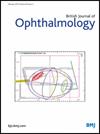Incidence and tumour location of iris melanoma in Denmark: a nationwide cohort study (1943–2021)
IF 3.5
2区 医学
Q1 OPHTHALMOLOGY
引用次数: 0
Abstract
Background/aims Iris melanoma differs from posterior uveal melanoma in clinical behaviour and location. Situated anteriorly, it is directly exposed to ultraviolet radiation (UVR), unlike posterior melanomas shielded by the lens. However, epidemiological patterns and UVR’s role in iris melanoma development remain poorly understood. Therefore, we investigated long-term incidence trends of iris melanoma in Denmark, focusing particularly on tumour location in relation to sun exposure. Methods We conducted a nationwide retrospective cohort study of patients diagnosed with iris melanoma in Denmark from 1943 to 2021. Population-based data were obtained from national registries and institutional records, with tumours classified by anatomical location as inferior, superior or mixed. Results We included 405 patients. Disease-specific mortality was 3% (12 patients), mainly in American Joint Committee on Cancer c-subcategories with secondary glaucoma and extensive anterior chamber angle involvement. Over the study period, the age-standardised incidence increased substantially. Inferiorly located tumours constituted 58% during 1943–1962 and 84% during 2003–2021 (p<0.001), with age-standardised incidence increasing from 0.15 per 100 000 in 1943–1954 to 0.97 per 100 000 in 2010–2014. Superior melanomas demonstrated non-significant increases over time. Age-period-cohort analysis revealed effects of both age and calendar period. The age effect demonstrated a sharp increase after age 65 years for both inferior and superior tumours while the calendar period effect showed increases only for inferior iris melanomas. Conclusions Iris melanoma incidence increased significantly over the 79-year study period, primarily driven by inferior iris tumours most exposed to the sun. These findings support the hypothesis that UVR plays a pathogenic role in iris melanoma development. Data are available on reasonable request. Due to current European GDPR regulations, we are not permitted to share detailed population data publicly. However, the data may be made available on reasonable request and following the signing of a data management agreement.丹麦虹膜黑色素瘤的发病率和肿瘤位置:一项全国性队列研究(1943-2021)
背景/目的虹膜黑色素瘤与葡萄膜后黑色素瘤在临床表现和位置上不同。它位于前面,直接暴露在紫外线辐射(UVR)下,不像后面的黑色素瘤被晶状体屏蔽。然而,流行病学模式和紫外线辐射在虹膜黑色素瘤发展中的作用仍然知之甚少。因此,我们调查了丹麦虹膜黑色素瘤的长期发病率趋势,特别关注肿瘤位置与阳光照射的关系。方法:我们对1943年至2021年在丹麦诊断为虹膜黑色素瘤的患者进行了一项全国性的回顾性队列研究。基于人群的数据是从国家登记处和机构记录中获得的,肿瘤按解剖位置分为低级、高级或混合。结果纳入405例患者。疾病特异性死亡率为3%(12例),主要是美国癌症联合委员会c亚类继发性青光眼和广泛前房角受累者。在研究期间,年龄标准化发病率显著增加。1943-1962年,下位肿瘤占58%,2003-2021年占84% (p<0.001),年龄标准化发病率从1943-1954年的0.15 / 10万增加到2010-2014年的0.97 / 10万。随着时间的推移,上黑素瘤没有明显的增加。年龄-时期-队列分析揭示了年龄和日历时期的影响。年龄效应显示,65岁以后,下、上两种肿瘤的年龄效应都急剧增加,而日历周期效应仅显示下虹膜黑色素瘤的年龄效应增加。结论:在79年的研究期间,虹膜黑色素瘤的发病率显著增加,主要是由于下虹膜肿瘤暴露在阳光下最多。这些发现支持了紫外线辐射在虹膜黑色素瘤发展中起致病作用的假设。如有合理要求,可提供资料。由于目前的欧洲GDPR法规,我们不允许公开分享详细的人口数据。但是,在合理要求和签署数据管理协议后,可以提供这些数据。
本文章由计算机程序翻译,如有差异,请以英文原文为准。
求助全文
约1分钟内获得全文
求助全文
来源期刊
CiteScore
10.30
自引率
2.40%
发文量
213
审稿时长
3-6 weeks
期刊介绍:
The British Journal of Ophthalmology (BJO) is an international peer-reviewed journal for ophthalmologists and visual science specialists. BJO publishes clinical investigations, clinical observations, and clinically relevant laboratory investigations related to ophthalmology. It also provides major reviews and also publishes manuscripts covering regional issues in a global context.

 求助内容:
求助内容: 应助结果提醒方式:
应助结果提醒方式:


